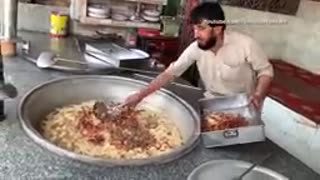Premium Only Content

Safety in the Kitchen_ Chopping Boards _ understanding Dirty Cloths
### **Safety in the Kitchen: Chopping Boards and Dirty Cloths**
Maintaining a safe kitchen environment is critical to prevent cross-contamination and ensure food safety. Two major culprits for spreading harmful bacteria are **chopping boards** and **dirty cleaning cloths**. Here’s how to manage these effectively:
---
### **Chopping Boards: Key Risks and Safety Practices**
#### **Why Chopping Boards are a Risk**
- **Cross-Contamination**: Raw food residue, like juices from raw meat or fish, can transfer bacteria (e.g., Salmonella, Campylobacter) to ready-to-eat foods.
- **Hidden Bacteria**: Deep scratches, grooves, and cracks in chopping boards can harbor bacteria, making cleaning ineffective.
- **Allergens**: Trace allergens left on boards can be dangerous for customers with food allergies.
#### **Best Practices for Chopping Boards**
1. **Use Colour-Coded Boards**:
Assign specific colours for different food types:
- **Red**: Raw meat
- **Blue**: Raw fish
- **Yellow**: Cooked food
- **Green**: Vegetables and salads
- **White**: Dairy and bakery items
This prevents accidental cross-use between food types.
2. **Clean After Each Use**:
- Scrub boards thoroughly with hot, soapy water immediately after use.
- Sanitize with a food-safe disinfectant to kill bacteria.
3. **Check for Damage**:
- Inspect boards regularly for cracks, grooves, or excessive wear.
- Replace boards showing signs of damage, as these areas can trap bacteria.
4. **Separate Boards for Allergens**:
- Use separate, clearly marked boards for foods containing allergens like nuts or gluten to avoid cross-contact.
5. **Storage**:
- Store boards vertically to ensure they dry thoroughly, preventing moisture build-up, which encourages bacterial growth.
---
### **Dirty Cloths: Key Risks and Safety Practices**
#### **Why Dirty Cloths are a Risk**
- **Spread of Bacteria**: Cleaning cloths used repeatedly without washing can transfer bacteria from one surface to another.
- **Moisture**: Damp cloths are a breeding ground for bacteria.
- **Cross-Contamination**: Using the same cloth for multiple tasks (e.g., wiping a raw meat surface and a prep area) spreads contaminants.
#### **Best Practices for Cleaning Cloths**
1. **Use Disposable Cloths**:
- Single-use, disposable cloths are the safest option to prevent bacterial spread.
2. **Wash Reusable Cloths Properly**:
- Launder cloths at high temperatures (at least 60°C) after every use.
- Avoid reusing cloths without washing them first.
3. **Keep Tasks Separate**:
- Assign specific cloths for different tasks, such as:
- One for cleaning raw meat surfaces.
- Another for wiping ready-to-eat prep areas.
- Colour-code cloths (e.g., red for raw meat areas, blue for general surfaces) to minimize mistakes.
4. **Sanitize Cloths During Use**:
- Soak cloths in a food-safe sanitizer between uses to reduce bacterial build-up.
5. **Dry Cloths Thoroughly**:
- Allow cloths to dry completely before reuse to discourage bacterial growth.
---
### **Practical Tips for Kitchen Safety**
#### **Chopping Boards and Cloth Management Together**
- **Cleaning Schedule**: Implement a cleaning schedule that includes chopping boards and cloths. Use checklists to track cleaning frequency and ensure compliance.
- **Training**: Train staff to understand the risks and follow best practices, such as:
- Switching cloths and boards during tasks.
- Cleaning and sanitizing equipment immediately after use.
- **Regular Inspections**: Supervisors should regularly inspect chopping boards and cleaning materials for wear, cleanliness, and proper use.
#### **The Role of SFBB in Kitchen Safety**
- Use the **Safer Food Better Business (SFBB)** pack to establish documented procedures for managing equipment hygiene.
- Record cleaning tasks, training, and monitoring to demonstrate compliance during inspections.
---
### **What to Avoid**
1. **Mixing Raw and Ready-to-Eat Prep Areas**: Always keep separate equipment and cloths for these zones.
2. **Using Worn Equipment**: Replace boards and cloths as soon as they show signs of wear.
3. **Skipping Cleaning Steps**: Rinse, clean, sanitize, and dry—don’t skip any steps.
---
By managing chopping boards and cleaning cloths effectively, you can greatly reduce the risk of cross-contamination and ensure a safer kitchen environment.
Would you like a **custom cleaning checklist** for your kitchen or further advice on training your staff?
-
 20:24
20:24
HSESafetyInformation
3 months agoKABULI PULAO RECIPE - Original 40+ KG Afghani Meat Pulau Prepared - Street Food Qabili Plav Recipe_2
29 -
 3:24:07
3:24:07
Barry Cunningham
6 hours agoJD Vance And Marco Rubio Speak at American Compass Fifth Anniversary Gala | And More News!
66.7K30 -
 2:52:45
2:52:45
TimcastIRL
5 hours agoTrump Admin ARRESTS Boulder Terrorists ENTIRE FAMILY, Preps Deportations | Timcast IRL
184K98 -
 2:40:48
2:40:48
RiftTV/Slightly Offensive
8 hours agoBig, Beautiful SCAM? Elon FLIPS on Trump for WASTEFUL Bill | The Rift | Guests: Ed Szall + Matt Skow
57.3K14 -
 LIVE
LIVE
SpartakusLIVE
7 hours agoSpecialist TOWER OF POWER || Duos w/ Rallied
526 watching -
 3:24
3:24
Glenn Greenwald
6 hours agoPREVIEW: Sen. Rand Paul Interview Exclusively on Locals
95.5K60 -
 3:54:13
3:54:13
VapinGamers
5 hours ago $1.57 earned⚔ 🔥 Blades of Fire - Game Review and Playthru - !game !rumbot #sponsored
37.8K5 -

ZWOGs
10 hours ago🔴LIVE IN 1440p! - Max Payne 3, Halo Infinite, Marvel Rivals, Splitgate 2, & Maybe Helldivers 2 - Come Hang Out!
14.6K -
 1:14:00
1:14:00
The Daily Signal
6 hours ago🚨LIVE: Democrats Champion Illegals Amid MORE ICE Arrests
45.8K1 -

RaikenNight
5 hours ago $0.21 earnedFinally got my surgery scheduled! Playing Tainted Grail
9.81K